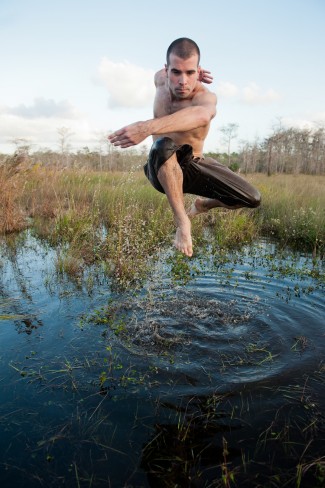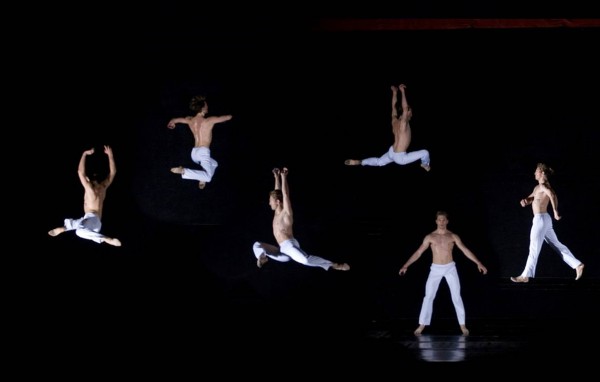REVIEW: Parsons Dance bounces off the stage at the Joyce

NEW YORK — Parsons Dance, offering its annual residency at the Joyce Theater through Jan. 27, explodes onto the stage with seemingly boundless energy. The dancers glide their feet, point their outstretched arms and carry one another to awesome heights. At times, it feels like the Joyce’s stage is unable to contain their spirited flying, as if they’ve gone positively celestial.
The two-hour program, overseen by artistic director David Parsons, features one world premiere, one New York City premiere and several company staples. There’s not much of a connection among the individual pieces, but when considered alone, this is a quintet of solitary masterpieces.
The evening begins with “Wolfgang,” an unusually transfixing set of dances performed to the music of Wolfgang Amadeus Mozart, namely “Symphony No. 25 in G minor 2 piano concertos”. Three pairs of dancers emerge from darkness, and they proceed to give and take their romantic effusion in group numbers. At times, it feels like the Parsons dancers are a chain, separated by flesh but somehow connected by spirit. They even sit on the floor and relax into one another’s arms, presenting a warped caterpillar of fondness.
Standouts in “Wolfgang” include Melissa Ullom, a dancer with the indescribable ability to stand out and fit in at the same time. Christina Ilisije, featured in almost every dance, has a unique quality of contorting her body in a moment, pushing and pulling between grace and ferocity. Elena D’Amario has not-so-quiet ripples of sheer beauty, like a never-ending spin around her male counterpart, her hair stretching out to impossible lengths, her balletic style on display for all to enjoy. The men, Jason MacDonald, Ian Spring and Eric Bourne, offer grandiose movements of accompaniment, and they leap across the stage both effortlessly and quickly. There’s a great moment in “Wolfgang” when the couples head left and right from stage curtain to stage curtain, and at the halfway point they steal a glance at the dancer behind them. It’s a frolicking gesture that fits both the choreography and music well.
The second piece, “Black Flowers,” is a deeply emotive dance choreographed by Katarzyna Skarpetowska. Three mourning women (Ullom, Ilisije and Lauren Garson) offer physical condolences in different poses and postures. The men (Bourne, MacDonald and Steven Vaughn) parade around the black-dressed women, seemingly trying to understand their intentions and sorrows. The dance, featuring music by Frederick Chopin, is hauntingly effective, and Christopher Chambers’ lighting design is muted and matched well with the movements on stage.
The highlight of the program is “Dawn to Dusk,” a multimedia piece that first premiered at the Wolf Trap National Park for the Performing Arts. Choreographed by Parsons, the ambitious dance features video images of the Everglades in Florida, including alligators, egrets and a host of plant life. The dancers perform routines in the wetlands on screen, and they also recreate some of those movements on the stage at the Joyce. Taken together, the competing images are almost symbiotic, feeding off each other. Individual dancers, namely Abby Silva Gavezzoli and Bourne, seem to perform in tandem with their High-Definition counterparts.
Animalistic is a good way to describe the movements, but there’s something also connective, with the dancers becoming one and breaking apart, back and forth, back and forth.
These first parts are set to the music of Andrew Bird’s “Master Sign,” “Carrion Suite” and “You Woke Me Up!” The final segment whisks us away from the Everglades and to Miami. With Tiempo Libre’s “Ven Pa Miami” blasting, the dancers, now in colorful costumes, salsa their way across the Joyce’s stage. D’Amario, who leads the bunch, is perhaps the most at home with this rhythmic style.
At first, the absence of a transition between the wetlands and the streets of Miami is jarring. This seems like two pieces brought together for no other reason than economy of theatricality, but Parsons finds the parallels. Watch for the final image when Tiempo Libre’s song finally winds down. We’re reminded that the Everglades aren’t too far away after all.

After an intermission, we’re given the signature piece, “Caught,” danced by Bourne at the performance I attended. This piece, running only a few minutes, is a visual spectacle that’s almost impossible to do justice in print. Using a strobe light and one dancer, the audience’s mind is tricked into believing that untethered flight is possible. The resulting dance is fast-paced and assaulting on the senses. It seems unlikely that a performance can move so fast and so in time with the demanding lighting effects. Bourne, deservedly, received the highest praise for his efforts.
“In the End,” set to the music of the Dave Matthews Band, finishes the program on a lighter note. Stitching together a few popular songs from the alternative rockers, including “Satellite” and “Stay,” the company number is colorful, bright and positive. The movements are complicated, but digestible, almost always going with the beats and matching the burst-outs of the lyrics. With the one-color shirts of the performers, plus their jeans, it all looks like a re-imagining of West Side Story. But Parsons goes deeper, never settling for easy movements. He seems more interested in exploring the limits of the body, and how unity can be both created and destroyed in a few minutes.
Parsons Dance is thankfully offering a little bit of everything at the Joyce. From the sorrows of mourning to the energy of youth to the sex appeal of Miami, this year’s showcase is a smorgasbord of modern-dance options.
By John Soltes / Publisher / John@HollywoodSoapbox.com

